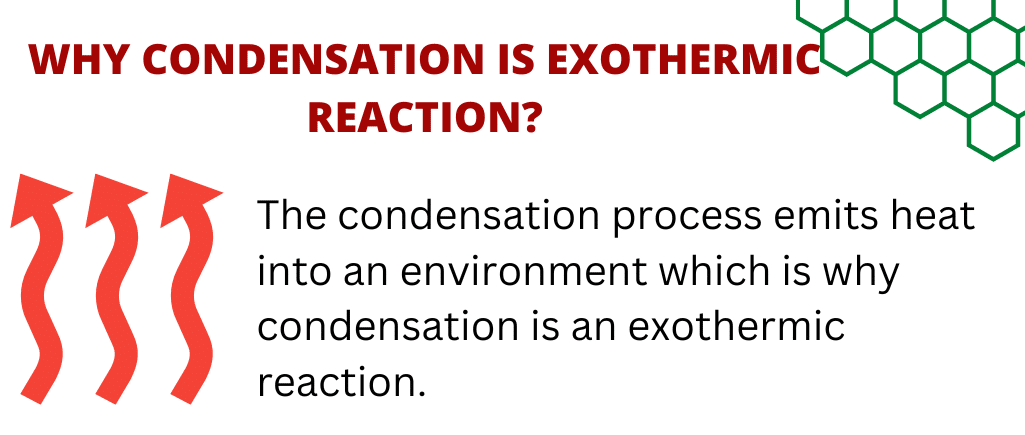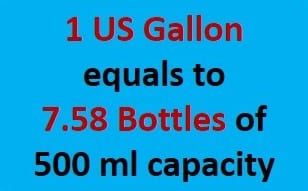Condensation is the transition from the gas to the liquid phase. Most commonly, it refers to the conversion of water vapour to liquid water, which occurs on cold surfaces. The condensation process emits heat into an environment which is why condensation is an exothermic reaction.

During this process, the molecules lose kinetic and potential energy during condensation, which is released as heat (thermal energy). Some examples of condensation reactions are listed below:
- When water droplets in clouds combine, they become heavy enough to fall from the sky as raindrops.
- When water vapour, or water in its gaseous state, condenses, fog forms.
- Moisture production is an example of a condensation reaction.
Table of Contents
Exothermic Condensation Reaction in Water Cycle
Exothermic condensation reaction occurs during the water cycle. By absorbing energy, liquid water evaporates and transforms into a gas during the water cycle process. The resulting gaseous vapours rise and circulate in the atmosphere before cooling and reverting to liquid. Since the cooling of water vapours is caused by the release of energy, condensation of vapours is an exothermic reaction.
Daily Life Examples of Condensation as an Exothermic Reaction
Condensation is an exothermic reaction because it releases heat when a gas or vapor is converted into a liquid. Here are some examples of condensation as an exothermic reaction in daily life:
- Boiling Water and Condensation on Pot Lid: When water is boiled in a pot, the water molecules absorb heat energy and turn into steam. When the steam comes into contact with the cooler lid of the pot, it loses energy and condenses back into liquid water droplets. This process releases heat into the surroundings.
- Dew Formation on Surfaces: Dew forms on surfaces, such as grass or cars, when the air temperature drops below the dew point temperature. The dew point is the temperature at which the air is saturated with water vapor, causing the excess water vapor to condense into liquid droplets on nearby surfaces. This process releases heat into the surroundings.
- Condensation on Cold Drink Glasses: When a cold drink is poured into a glass on a warm day, the air around the glass is cooled. This causes the water vapor in the air to condense on the surface of the glass, forming droplets. This process releases heat into the surroundings.
- Condensation in Bathrooms: When a warm shower is taken in a bathroom, the warm, moist air from the shower can cause condensation to form on the cool surfaces of the bathroom, such as mirrors and walls. This process releases heat into the surroundings.
- Condensation on Spoonful of Hot Soup: When a spoonful of hot soup is blown on, the water vapor in the breath condenses on the cooler spoon, releasing heat into the soup and warming it up.
- Condensation in Cold Weather: When warm, moist air is exhaled into cold outdoor air, the water vapor in the breath condenses and forms a visible mist. This process releases heat into the surroundings.
- Cloud Formation in Atmosphere: When warm, moist air rises and cools in the atmosphere, the water vapor condenses into liquid droplets, forming clouds. This process releases heat into the surroundings.
- Sweat Condensation During Exercise or Hot Weather: When the body sweats, the sweat on the skin evaporates into the air, cooling the body. When the sweat comes into contact with cooler air, it can also condense back into liquid droplets, releasing heat into the surroundings.
Frequently Asked Questions
| # | Questions | Answer |
| 1 | Explain why condensation is an exothermic reaction. | Condensation is an exothermic reaction because it involves the release of heat when a gas or vapor is converted into a liquid. |
| 2 | Describe the energy changes that occur during condensation. | During condensation, the energy of the gas or vapor is converted into the energy of the liquid, and heat is released. |
| 3 | Compare and contrast the energy changes during condensation and evaporation. | In condensation, heat is released, while in evaporation, heat is absorbed. Additionally, condensation involves a phase change from gas to liquid, while evaporation involves a phase change from liquid to gas. |
| 4 | What factors can affect the amount of heat released during condensation? | The amount of heat released during condensation can be affected by factors such as the temperature of the surrounding environment, the pressure of the system, and the properties of the substance undergoing condensation. |
| 5 | How does the temperature of the surrounding environment affect the amount of heat released during condensation? | The temperature of the surrounding environment can affect the amount of heat released during condensation because it can determine the degree to which the gas or vapor is cooled, and therefore the amount of energy that is released during the phase change. |
| 6 | Provide an example of a natural process that involves condensation as an exothermic reaction. | An example of a natural process that involves condensation as an exothermic reaction is the formation of dew on surfaces overnight. As the temperature drops, water vapor in the air condenses into liquid droplets on surfaces, releasing heat in the process. |
| 7 | Explain why the process of dew forming on grass in the early morning is an example of condensation as an exothermic reaction. | The process of dew forming on grass in the early morning is an example of condensation as an exothermic reaction because as water vapor in the air condenses into liquid droplets on the grass, heat is released and warms the surrounding environment. |
| 8 | Why does the formation of clouds in the atmosphere involve condensation as an exothermic reaction? | The formation of clouds in the atmosphere involves condensation as an exothermic reaction because as water vapor in the air rises and cools, it condenses into liquid droplets, releasing heat in the process and forming clouds. |
| 9 | Describe an experiment that could be performed to demonstrate that condensation is an exothermic reaction. | An experiment that could be performed to demonstrate that condensation is an exothermic reaction involves measuring the temperature of a gas or vapor as it undergoes condensation, and observing that the temperature increases as heat is released during the process. |
| 10 | How does the concept of enthalpy relate to the exothermic nature of condensation? | Enthalpy is a measure of the total heat content of a system, and during condensation, the enthalpy of the system decreases as heat is released. Therefore, the exothermic nature of condensation can be understood in terms of a decrease in enthalpy. |
More Links
- BCl3 Lewis Structure in four simple steps - November 1, 2023
- PH3 Lewis Structure in four simple steps - October 8, 2023
- PF3 Lewis structure in four simple steps - September 24, 2023



